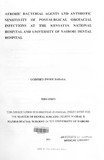| dc.contributor.author | Barasa, Godfrey B | |
| dc.date.accessioned | 2013-05-24T12:34:07Z | |
| dc.date.available | 2013-05-24T12:34:07Z | |
| dc.date.issued | 2011 | |
| dc.identifier.citation | Master of dental surgery degree in oral & Maxillofacial surgery | en |
| dc.identifier.uri | http://erepository.uonbi.ac.ke:8080/xmlui/handle/11295/25432 | |
| dc.description.abstract | Main objective: The aim of this study was to determine the aerobic bacterial agents and
antibiotic sensitivity of post-surgical infections in the orofacial region.
Methodology: clinical case evaluation and laboratory investigation of microbial sensitivity to
antibiotics.
Clinical methods: Patients were evaluated for post-surgical wound infection from the 5th
post-operative day up to the 30th post-operative day unless a surgical implant was in situ
when the period was extended to up to a year. The specimens were collected using sterile
swabs and transported to the microbiology laboratory within 2 hours of collection.
Laboratory methods: The specimens were then analysed for bacteriology according to the
standard bacteriological techniques. A wide range of antibiotics including those commonly
used to treat orofacial infections were tested for sensitivity against the isolates obtained using
the disk diffusion test (Bauer-Kirby procedure, using CLSI protocols).
Results: Both gram-negative and positive bacteria were isolated. Staphylococcus aureus
formed 40% of the isolates followed by Klebsiella species (23%) and the Pseudomonas
species (l9%).Amoxycillin/clavulinic acid, the 2nd and 3rd generation cephalosporins were
effective against most of the bacteria. Enterobacteriaceae showed high susceptibility to
levofloxacin and carbapenems. The Pseudomonas species was highly susceptible to the 3rd
generation cephalosporins and carbapenems.
Conclusion: The bacteria isolated in the infected surgical site wounds in the oro-facial region
are Staphylococcus aureus, Klebsiella species, and Pseudomonas species with augmented
penicillins and newer generations of cephalosporins still being effective against
them.Cabapenems remained highly effective against a large variety of bacteria. | en |
| dc.language.iso | en | en |
| dc.publisher | University Of Nairobi | en |
| dc.title | Aerobic bacterial agents and antibiotic Sensitivity of post-surgical orofacial Infections at the Kenyatta national Hospital and university of Nairobi dental Hospital | en |
| dc.type | Thesis | en |
| dc.description.department | a
Department of Psychiatry, University of Nairobi, ; bDepartment of Mental Health, School of Medicine,
Moi University, Eldoret, Kenya | |
| local.publisher | College of Health Sciences | en |

